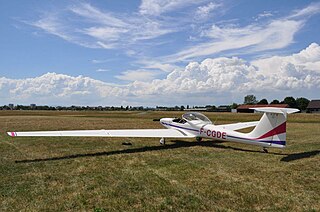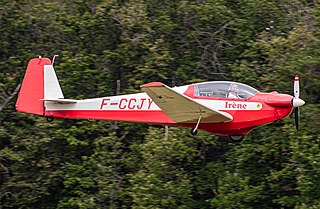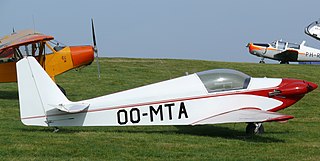
The Fournier RF 5 is a two-seat motor glider designed by René Fournier.

The Fournier RF 4 is a single-seater motor glider designed by René Fournier in 1966. It is an aerobatic version of the Fournier RF 3.

The Valentin Taifun is a two-seat self-launching sailplane designed and built by Valentin Flugzeugbau GmbH of Hasfurt, Germany.

The Scheibe SF-25 Falke is a German touring motor glider developed from the earlier Bergfalke glider by Scheibe Flugzeugbau. Since May 2006 the business has been run by Scheibe Aircraft GmbH.
The Fisher Culex and Culite are a family of American two-seat, twin-engined monoplanes. The aircraft is supplied in the form of blueprints for amateur construction, originally by Fisher Flying Products and now by Mike Fisher Aircraft.

The Aeromot AMT-200 Super Ximango is a Brazilian motor glider developed from the AMT-100 Ximango but fitted with a Rotax 912 engine.

The Whisper Aircraft Whisper motor glider is a South African two-seat kit aircraft that was designed by Russell Phillips in 2004 and is produced by Whisper Aircraft of Port Elizabeth. Major assemblies are completed at the factory with assembly intended to be completed by the owner. It is powered by a four-cylinder Limbach L2000 aero engine with options for the 85 hp (63 kW) Jabiru 2200 and 80 hp (60 kW) Rotax 912 available.

The Fournier RF-10 is a two-seat motor glider designed by René Fournier in 1981. The aircraft is a further development of the RF-9 and incorporated plastic and carbon-fiber structures.

The Scheibe SF 28 Tandem-Falke is a German motorglider that was designed by Egon Scheibe in 1970 and which flew for the first time in May the following year. It was a development of the Scheibe Falke with seating in tandem rather than side-by-side as in the original Falke design.
The Lucas L6 is a French all-metal monoplane design for homebuilding by Emile Lucas.
The Shenyang HU-2 Petrel is a Chinese self-launching motor-glider built by the Shenyang Sailplane Factory at Shenyang.

The Fournier RF7 was a single-seat motorglider designed and built in prototype form by René Fournier in France in 1970 and intended for series production by Sportavia-Pützer in Germany.

The Diamond HK36 Super Dimona is an extensive family of Austrian low-wing, T-tailed, two-seat motor gliders that were designed by Wolf Hoffmann and currently produced by Diamond Aircraft Industries.
The Lucas L-6A, also called the L6A, is a French low-wing, two-seats in tandem motor glider that was designed by Emile Lucas of Lagny-le-Sec in the form of plans for amateur construction.
The Kortenbach & Rauh Kora 1 was an unusual twin boom, pusher configuration motor glider, designed and built in Germany in the 1970s and intended as a training aircraft.

The Fournier RF-3 is a single-seat motor glider designed by René Fournier and first flown in 1960.

The Politechnika Warszawska PW-4 Pelikan was a motor-glider variant of the two seat Polish PW-3 Bakcyl glider. Only one flew.

The Aeromot AMT-600 Guri is a two-seater light aircraft with a low cantilever wing and fixed tricycle landing gear from Brazil.
The Aeromot AMT-300 Turbo Ximango Shark is a Brazilian motor glider manufactured by the aerospace company Aeromot.
The CETEC-303 CB.7 Vesper is a Brazilian motor glider designed by Cláudio de Barros.













